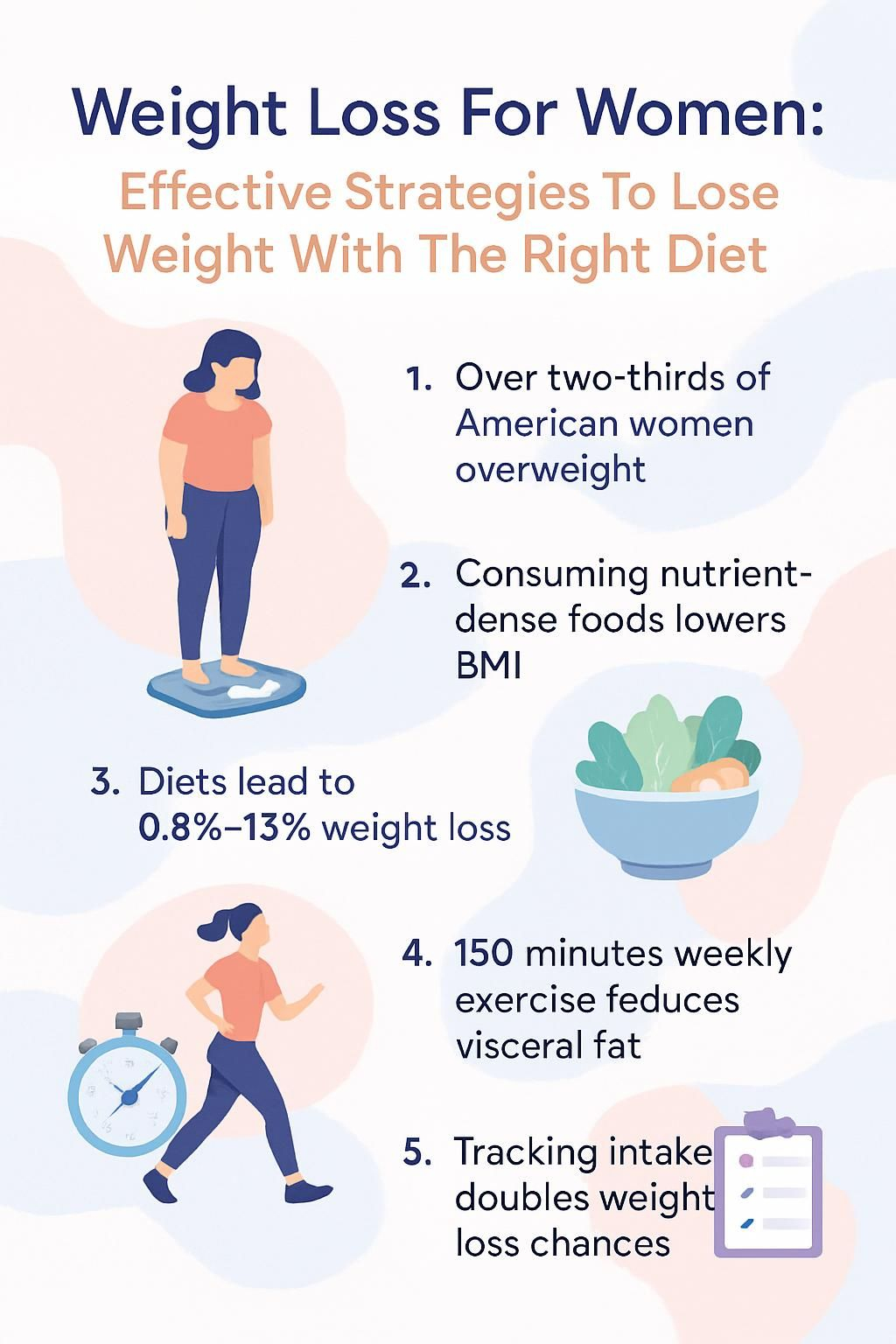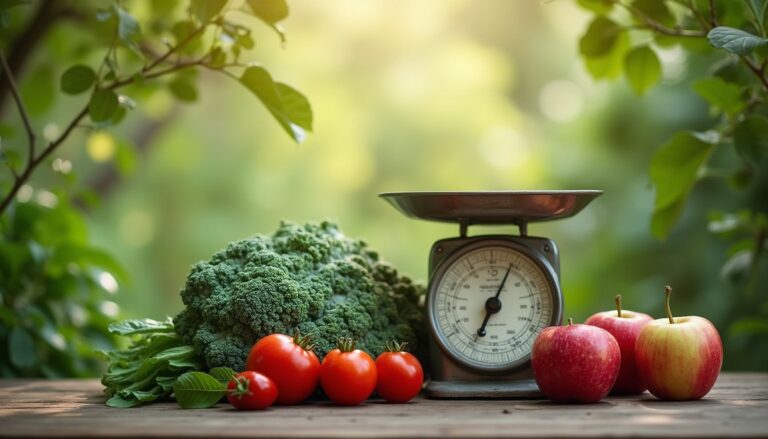Weight Loss For Women: Effective Strategies To Lose Weight With The Right Diet
Our Nutrition Assistant AI Suite will transform your body. You will lose fat, get toned, and build muscle. Gain confidence and optimal health.
If you struggle to lose weight and keep it off, you are not alone. More than two thirds of American women live with overweight or obesity, which can affect health and confidence. Weight loss takes more than willpower. Hormones, metabolism, and the right diet all matter.
Weight Loss For Women often includes unique hurdles like shifting hormones, a slower resting metabolism, and busy schedules. This guide gives you clear steps, healthy eating habits, and exercise tips backed by research. Use it to build a plan that fits your life and supports a healthy weight.
Here is what works for women who want lasting fat loss without guesswork. This guide is educational and not medical advice. Talk with a licensed clinician before major changes to your diet, supplements, or exercise.
Key Takeaways
- Over two thirds of American women have overweight or obesity. Hormonal changes, slower metabolism, and life stages can make weight loss harder than for men (Dr. Ann Smith).
- Choosing nutrient dense foods like whole grains, fruits, vegetables, and lean proteins while limiting processed foods and sugary drinks supports lower BMI and long term weight management (American Heart Association).
- Low Calorie Diets, Low Carbohydrate Diets, the Mediterranean Diet, and Intermittent Fasting produce average losses of about 0.8 percent to 13 percent across two months to one year in clinical studies (NIH and related research).
- Combining at least 150 minutes per week of aerobic exercise with regular strength training boosts calorie burn, preserves muscle mass, and helps reduce visceral belly fat in women (CDC, NEJM 2015).
- Tracking food intake with journals or apps can double the chance of losing weight compared with not tracking. A steady goal of 1 to 2 pounds per week improves blood pressure and cholesterol (CDC, Wing et al., NEJM 2020).

Key Factors Affecting Weight Loss in Women

Women face distinct weight loss challenges as hormones and metabolism shift across life stages. Understanding these drivers helps you set better goals and support healthy body composition with the right diet strategy.
How does weight loss differ between men and women?
Men often lose weight faster than women who follow the same plan. One reason is muscle mass. Men tend to have more lean muscle, which burns more calories at rest. That gives men a small metabolic edge.
Women usually carry more fat mass and less lean tissue. Hormones also influence how fat is stored and released. Pregnancy and menopause can slow progress, especially for abdominal fat.
It is common for two people in the same home to see different results even with the same plan,
says Dr. Ann Smith, a nutrition expert. Keep these differences in mind and judge progress by your own trend, not someone else’s timeline.
What role do hormones, metabolism, and life stages play in weight loss?
Hormones, metabolism, and life stages shape how you lose weight. Estrogen affects where fat is stored. During perimenopause and menopause, lower estrogen is linked to more belly fat and a higher risk for heart disease and type 2 diabetes.
Metabolism also slows with age. Adults lose muscle if they do not strength train, which reduces calories burned at rest. Adjusting your workouts and protein intake helps protect muscle as you age.
Adapting your diet and activity at each stage supports steady progress and long term weight management.
Summary Table:
| Life Stage | Hormonal Changes | Impact on Weight |
|---|---|---|
| Adolescence | Higher estrogen and progesterone | Faster changes in weight during growth spurts |
| Pregnancy and Postpartum | High and shifting hormones | Greater risk of excess fat gain |
| Perimenopause and Menopause | Lower estrogen | Slower metabolism and more abdominal fat |
Watching hormones, protecting metabolism, and adjusting your plan at each stage will help you lose weight safely.
Why Is a Balanced Diet Crucial for Weight Loss?
A balanced diet helps you lose weight and protect your health. Filling most meals with whole grains, fruits, vegetables, lean proteins, and healthy fats makes steady weight loss easier.
What are nutrient-dense foods and why choose them?
Nutrient dense foods deliver lots of vitamins, minerals, and fiber for fewer calories. Great options include whole grains, leafy greens, berries, beans, lentils, fish, chicken breast, nuts, and seeds.
These foods keep you full, reduce cravings, and help manage blood sugar. The American Heart Association encourages eating more fruits and vegetables to support healthy blood pressure and cholesterol.
Eating more nutrient dense foods helps each calorie move you closer to better health.
How do processed foods and sugary drinks affect weight loss?
Processed foods and sugary drinks work against your goals. They often pack added sugar, salt, unhealthy fats, and extra calories. Liquid calories from soda do not trigger fullness like solid foods, which can lead to overeating.
These choices can spike blood sugar and insulin, which may raise fat storage around the abdomen. Swapping one daily soda for water or unsweetened tea can support weight loss within a few months. A large review links sugar sweetened drinks with higher odds of overweight and obesity.
Why include healthy fats and proteins in your diet?
Healthy fats and proteins help you stay full and reduce cravings. Fats from avocados, nuts, seeds, and olive oil support brain health and hormones. Dietary fat also helps you absorb vitamins A, D, E, and K.
Protein builds and protects muscle. Muscle keeps metabolism higher during weight loss. You also burn more calories digesting protein than carbs or fat. Research shows that raising protein from 15 percent to 30 percent of total calories can naturally cut daily intake by about 441 calories without extra hunger (Weigle et al., 2005).
A simple example is a high protein breakfast, such as eggs with spinach, to stay full until lunch and reduce snacking. Choosing foods rich in healthy fats and protein often beats any fad diet high in sugar or refined carbs.
Which Dietary Strategies Are Most Effective for Weight Loss?
Different eating patterns can help you lose fat and maintain weight, depending on your needs and routine. The best plan is one you can follow consistently.
What is a Low-Calorie Diet (LCD) and how does it work?
A Low Calorie Diet trims daily intake, often to about 1,200 to 1,500 calories for women. You create a calorie gap, so your body uses stored fat for energy.
Many people follow an LCD with a clinician to ensure proper nutrition and avoid fatigue. Some plans include meal replacement shakes for structure. Calorie restriction works, but quality still matters, so include protein, produce, and healthy fats (American Heart Association; NIH).
How do Low-Carbohydrate Diets support weight loss?
Low carbohydrate diets limit carbs, which can lower insulin and curb appetite. Your body then taps stored fat for energy. Many women see greater short term weight loss with low carb compared with standard low fat plans.
Typical ranges are 50 to 150 grams of carbs per day, based on goals. Focus on non starchy vegetables, lean proteins, and healthy fats. Reducing refined carbs and sugary drinks supports heart and blood vessel health and lowers diabetes risk.
What are the benefits of the Mediterranean Diet?
The Mediterranean Diet centers on plant foods and healthy fats. You eat fruits, vegetables, whole grains, beans, nuts, olive oil, seafood, and some dairy. Olive oil provides monounsaturated fats, which protect arteries and veins.
Studies link this pattern with lower risk of cardiovascular disease and steady weight loss without strong hunger. Fiber rich foods in this plan help digestion and fullness. Many people report better energy when they swap processed snacks for fresh ingredients.
How do Time-Restricted Eating and Intermittent Fasting help lose weight?
Time Restricted Eating and Intermittent Fasting limit eating to set hours. During fasting, your body uses stored fat for fuel. Studies show average weight loss of about 0.8 percent to 13 percent over two months to one year.
These methods can improve insulin sensitivity, which helps control blood sugar. Many find the approach simple because there is no need to track every calorie. Pair fasting with nutrient dense meals, enough protein, and regular exercise for best results.
How Does Exercise Influence Weight Loss?
Exercise is a powerful partner to diet. It increases calorie burn, protects muscle, and strengthens your heart and lungs.
Why is regular physical activity important for weight loss?
Regular activity helps you burn more calories and avoid regaining weight. Moderate aerobic exercise, such as brisk walking or swimming, raises your heart rate and uses fat for energy.
About 150 minutes per week can support a 2 to 3 kilogram loss over several months when paired with a smart diet. You may also notice better mood, sleep, and energy. Group classes or a walking buddy can make consistency easier.
How does strength training help build muscle and reduce fat?
Aerobic work burns calories, but strength training builds muscle and lifts your resting metabolism. Women start with less muscle than men, so this matters even more for weight loss and healthy body composition.
Simple moves like squats, rows, and pushups reshape your body and improve how clothes fit. Research shows that resistance training plus diet reduces visceral fat, the deeper fat around organs, more than diet alone.
Aim to train all major muscle groups two or three times each week.
Summary Table: Strength Training Benefits
| Benefit | Evidence or Example |
|---|---|
| Raises calorie burn | Muscle uses more energy at rest than fat |
| Builds lean tissue | Improves shape and confidence |
| Lowers visceral fat | Studies show deeper belly fat drops with resistance work |
| Supports bone health | Weight bearing moves strengthen bones |
What are effective workouts like walking, swimming, and HIIT?
Walking, swimming, and HIIT give practical options for busy schedules. Mix them through the week to keep workouts fresh.
- Walking is simple and low cost. Aiming for 10,000 steps can raise calorie burn and support circulation.
- Swimming is gentle on joints yet works the full body. A 155 pound woman may burn about 230 to 266 calories in 30 minutes.
- High Intensity Interval Training, or HIIT, alternates hard bursts with recovery. It can burn up to 30 percent more calories than steady cardio.
- Adding strength moves to HIIT, like lunges and presses, helps build muscle and lift metabolism.
- Short walks after meals can blunt blood sugar spikes, which supports weight control.
- Combining aerobic days with resistance days improves body composition faster than either alone.
- Group workouts add motivation and accountability, which helps you stick to your weight loss plan.
- Regular exercise supports deeper sleep. Poor sleep can disrupt appetite and stress hormones.
- MyPlate encourages daily movement as part of healthy weight loss, especially during PMS or menopause.
- Daily brisk walks can boost energy and mood throughout your journey.
These options support fat loss while protecting lean muscle for long term results.
What Lifestyle Changes Support Weight Loss?
Small daily habits add up. Focus on sleep, stress control, and limiting alcohol and tobacco to support weight management.
How does quality sleep affect weight loss goals?
Quality sleep helps balance appetite hormones. Less than 7 hours of sleep is linked with stronger cravings and lower leptin, the fullness signal. Poor sleep also raises ghrelin, the hunger hormone.
Fatigue makes it harder to plan meals or exercise. Making sleep a priority helps your body burn calories more efficiently and keeps your willpower strong through the day.
What stress management techniques help with weight loss?
Chronic stress raises cortisol, which can increase hunger for sugary or fatty foods. Mindfulness, yoga, meditation, and deep breathing lower stress and improve self control around eating.
Ten minutes a day can help limit emotional eating. Light journaling can reveal patterns between mood and food, which makes it easier to replace habits that do not serve your goals.
Why reduce alcohol intake and avoid smoking for weight loss?
Alcohol adds quick calories. A single glass of wine has about 120 calories, and mixed drinks can be much higher. Alcohol also slows fat burning and can trigger salty snack cravings.
Smoking does not support healthy weight loss. It harms metabolism and increases disease risk. Many people notice improved stamina for exercise after quitting, which helps with steady fat loss. Cutting alcohol and tobacco supports safer, sustainable progress.
How Can Medical Guidance Assist in Weight Loss?
Professional help can make your plan safer and more effective, especially if you have medical conditions or take prescription drugs.
When should you consult healthcare professionals for weight loss advice?
Seek care if weight changes are rapid or unexplained. Ask for guidance if your BMI is below 18.5 or above 30, or if you have conditions like diabetes, heart disease, or sleep apnea.
Pregnant women and anyone with a history of eating disorders should talk with a clinician before starting a diet or supplement. Get help right away for chest pain, severe dizziness, or shortness of breath during exercise.
What medications or supplements are available for weight loss?
Prescription options include orlistat, phentermine topiramate, bupropion naltrexone, and GLP 1 medicines such as liraglutide. These can reduce appetite or block some fat absorption.
Most are approved for adults with BMI 30 or higher, or 27 with conditions like type 2 diabetes. Over the counter supplements, such as green tea extract, glucomannan, or caffeine blends, may offer small effects, often under five pounds. Always speak with your clinician first to avoid side effects and drug interactions.
When is bariatric surgery an option for severe obesity?
Bariatric surgery may be considered for BMI 40 or higher, or BMI 35 with serious conditions like diabetes, high blood pressure, or sleep apnea. Surgery changes the digestive system to help you feel full sooner and absorb fewer calories.
Clinicians review your health, readiness, and support system. Many patients lose 50 percent to 70 percent of excess weight within two years. Long term success still depends on healthy eating and activity.
How to Build Long-Term Weight Loss Success
Lasting weight loss comes from consistent habits. Tracking, setting realistic goals, and celebrating milestones make it easier to stay the course.
How can tracking progress with a food journal or app help?
Tracking shows what and how much you eat. It reveals patterns like mindless snacking, large portions, or hidden liquid calories.
People who track intake lose about twice as much as those who do not. Many apps display calories, protein, fiber, and added sugar to guide better choices. Reviewing a week at a time helps you fix small issues before they grow.
What are realistic and achievable weight loss goals?
Aim to lose 1 to 2 pounds each week. This pace is safe and more likely to last. A first goal of 5 percent to 10 percent of starting weight improves blood pressure, cholesterol, and blood sugar.
Break goals into monthly steps and track progress. Celebrate non scale wins, such as better sleep or walking farther without stopping.
Why celebrate small milestones during weight loss?
Small wins keep motivation high. Noticing better sleep, fewer cravings, or the first five pounds lost shows your plan is working.
Simple rewards, like a new water bottle or workout playlist, reinforce the habit. Regular recognition helps people stick with healthy routines (Wing et al., NEJM 2020).
How to stay patient and persistent through plateaus?
Plateaus are normal. Your body adapts to a new intake and activity level. Focus on daily actions you can control, not just the scale.
Try small changes, such as adding a strength day, increasing protein, or trimming 100 to 150 calories from snacks. Track for two more weeks and watch for fresh signs of progress, such as looser clothes or faster walks.
What Does a Sample Weight Loss Meal Plan Look Like?
A simple meal plan helps you make smart choices without feeling deprived. Think balanced plates, reasonable portions, and regular meal times.
What is a healthy breakfast option for weight loss?
Oatmeal with berries and scrambled eggs offers a strong start. Oats provide fiber that slows digestion and supports fullness. Berries add flavor and vitamins with few calories.
Eggs supply high quality protein to protect muscle. Greek yogurt with fruit and sliced almonds is another quick option that keeps mid morning cravings away.
Nutritional Content Example:
| Breakfast Item | Calories | Protein (g) | Fiber (g) |
|---|---|---|---|
| 1 cup oatmeal | 154 | 6 | 4 |
| 1/2 cup berries | 42 | 0.5 | 2 |
| 2 large scrambled eggs | 140 | 12 | 0 |
Combining fiber rich carbs and lean protein supports steady energy and weight loss.
What should a weight loss-friendly lunch include?
Build lunch around lean protein like grilled chicken, tofu, beans, or salmon. Add colorful vegetables for volume and nutrients. Include a small portion of whole grains, such as quinoa or brown rice, for lasting energy.
A drizzle of olive oil or a few avocado slices can improve fullness and flavor. Choose water or unsweetened tea instead of sugary drinks.
What are good dinner choices for weight loss?
Keep dinner simple and balanced. Choose lean proteins like baked fish, turkey, or tofu. Fill half your plate with non starchy vegetables, such as broccoli, spinach, or Brussels sprouts.
Add a quarter plate of whole grains or starchy vegetables. Use herbs, citrus, and spices for flavor instead of heavy sauces. Roasting vegetables instead of frying helps you stay within your daily calorie target while keeping meals satisfying.
What snacks support weight loss goals?
Greek yogurt with berries offers protein and fiber for few calories. A small handful of almonds or walnuts provides healthy fats and crunch.
Cut vegetables with hummus add flavor and fiber. Hard boiled eggs are another portable choice with about 6 grams of protein for only 78 calories. Choose whole foods and watch portions to stay on track.
What Challenges Do Women Commonly Face in Weight Loss?
Many women face monthly shifts, menopause symptoms, and emotional eating. Knowing your patterns helps you plan ahead.
How does the menstrual cycle affect weight and water retention?
Hormone changes before your period can cause bloating and water retention. Temporary weight gain of 1 to 5 pounds is common. This is water, not fat, and usually fades a few days after bleeding starts.
Drinking water and limiting salty foods can ease swelling and discomfort. Track your cycle so you can compare progress week to week.
What weight loss challenges occur during menopause?
During menopause, lower estrogen can shift more fat to the abdomen. Metabolism slows, so you burn fewer calories at rest. Sleep problems may raise hunger hormones, which can increase cravings.
Strength training, higher protein intake, and a regular sleep schedule help counter these changes. Patience and consistency are key.
How can women manage cravings and emotional eating?
Use a food journal or app to spot triggers like stress, boredom, or cycle changes. Plan balanced meals with protein and fiber to control hunger.
Practice mindful eating, slow down, and check in with your hunger level. If a craving hits, try a short walk or call a friend. If urges feel frequent or intense, consider speaking with a clinician or counselor for added support.
What Are the Benefits of Healthy Weight Loss?
Healthy weight loss delivers more than a lower number on the scale. It supports energy, disease prevention, and mental well being.
How does weight loss improve energy and overall health?
Losing weight improves how your body uses insulin, which helps turn food into energy. Less fat also reduces strain on your heart and joints. Even a 5 percent to 10 percent drop in body weight can raise energy and reduce daily fatigue.
Many people notice lower blood pressure and fewer aches. Breathing during exercise often feels easier as fitness builds.
How does losing weight reduce risks of diabetes and heart disease?
Fat around the abdomen raises blood pressure, raises LDL cholesterol, and harms blood sugar control. Losing just 5 percent to 10 percent of body weight can cut the risk of type 2 diabetes and support healthier cholesterol levels.
Research from the American Heart Association shows that modest weight loss can lower the risk of cardiovascular events. Every pound lost moves pressure off your heart and blood vessels.
How does weight loss enhance confidence and mental well-being?
Reaching a healthy weight often boosts confidence. Seeing progress in photos or feeling better in your clothes can lift your mood.
One study found women who lost at least 10 percent of body weight reported higher self esteem and less anxiety within six months. Better energy and consistent routines can improve focus at work, at home, and in social life.
Conclusion
Weight loss for women is not one thing. It is a set of steady habits. Choose nutrient dense foods, limit processed items, and keep moving. Support hormones and metabolism with enough protein and regular strength work.
Track intake, set realistic goals, and celebrate small wins. If progress stalls or health issues appear, talk with a clinician. With patience and a clear plan, you can lose weight, protect your health, and feel more confident every day.
FAQs
1. What are the most effective strategies for weight loss in women using the right diet?
Research shows that combining a balanced meal plan with regular activity helps women lose weight and keep it off. Studies suggest eating more vegetables, lean proteins like chicken or fish, whole grains such as brown rice, and healthy fats from nuts or avocados supports steady progress. Tracking food intake can also help identify patterns that slow results.
2. How does calorie intake affect weight loss for women?
Reducing daily calories is key to losing body fat. Data from clinical trials indicate that cutting 500 calories per day often leads to about one pound of weight loss each week (National Institutes of Health). Choosing nutrient-rich foods over processed snacks makes this easier while keeping energy levels stable.
3. Are there specific nutrients important for women’s diets during weight loss?
Yes, certain nutrients play a vital role in supporting health during dieting. Calcium found in dairy products strengthens bones; iron from beans or spinach prevents fatigue; fiber aids digestion and keeps you full longer (Harvard School of Public Health). Including these nutrients ensures safe and lasting results.
4. Can personal experience help guide dietary changes for better results?
Personal stories highlight how small adjustments make a difference over time. For example, swapping soda for water helped me reduce sugar intake without feeling deprived; planning meals ahead made it easier to avoid fast food after workdays grew busy. These habits support long-term success by making healthy choices routine.
Summary: Effective strategies include balanced nutrition, calorie control, attention to key nutrients like calcium and iron, plus practical changes based on real-life experiences. Research supports these steps as reliable ways to achieve lasting weight management outcomes for women seeking healthier lives through diet improvements.







